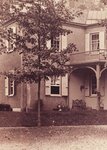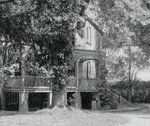


Architect J. Robert Hillier, owner of the property, assures us that the demolished mansion called Cintra will be rebuilt — the exterior will be almost identical to the original, but better.
Replication, Hillier told the New Hope Borough Council back in January, is the best path forward.
Photographs taken in 1917 show that the building was already failing. The walls, made of a soft, soluble argillite stone, were deteriorating; they will be replaced with stronger, load-bearing materials. The yellow pebble-dash stucco was peeling for years; the exterior walls will be covered with a modern mix that can resist the elements.
Brick trim that embellished corners will be reapplied. The long-gone porches and balconies will be restored and the lattice that adorned them will be back.
The mansion will hold four condominium units after the first building phase of the 29-unit Joseph Stanley Park project.
Rather than repair an ailing structure that was “beyond repair,” structural engineers recommended demolition of the mansion. Anthony Naccarato is the principal engineer for the current project. Peter Primavera, an authority on cultural resources and historic preservation, is advising the Hillier designers on replication of the historic building.
Cintra, which is on the National Register of Historic Places, was the vision of William Maris, who built mills along the Aquetong Creek. He was a partner with Benjamin Parry and Lewis Coryell in building the Union Mills at the south end of New Hope. On a visit to Portugal, the story goes, Maris saw Sintra Castle, whose plans he adapted for his mansion in New Hope, which was completed in 1816.
However, the late Cornelius Peck wrote to the Herald when the Cintra project was proposed: “After living nearly 40 years at Cintra, the old farm-estate on West Bridge Street in New Hope ... I wish to still the annoying and persistent rumor that the historical mansion is a copy of a villa in Portugal.
“The name Cintra refers to the 5 acres still remaining on the estate. The farm at one time extended behind the mansion, barn, ice house, studio and wagon barn (all still extant) across Kiltie Drive (developed into suburban homes in the ‘50s and ‘60s) and down the mountainside to the railroad and stream below.”
Peck called Cintra Mansion, purely Federal in period. “Every brick, stone, mantle, trim, cornice, window detail is pure and significant American Federal. Most important, the floor plan bespeaks that period nearly better than the famous Gore Place in Waltham, Mass., or even the few Federal homes spotted around Georgetown in Washington,” Peck wrote.
“Cintra in New Hope is Bucks County’s single gem of American Federal architecture. Perhaps Philadelphia’s Strawberry Mansion and Woodlawn of the same period cannot match it.”
In the 1830s, Maris, Cintra’s creator, sold the house to Richard Randolph, who sold it to his brother-in-law, Elias Ely, in 1884. It remained in the Ely family until the early 20th century.
Joseph Stanley, the owner before Hillier purchased it, and Dewey Lee Curtis, met each other when they were students at the University of Virginia. In the 1960s, they moved to Bucks County — Stanley opened an antiques business in New Hope and Curtis worked as the first curator of Pennsbury Manor, William Penn’s recreated home in Falls Township. Through his interest in history and furniture, Curtis founded the Decorative Arts Trust, which became an international organization.
According to one description, Stanley and Curtis, on finding Cintra, “were enthralled by its unusual design, stately interiors, and rich historical significance.” Stanley created a furniture showroom on the first floor and Curtis joined him in the business. The two filled the house with 18th- and 19th-century art and antiques purchased on their many trips abroad. They were known for their entertainment of colorful guests.
After Curtis died, in 1986, Stanley continued packing antiques into the building. He died in 2008, and the voluminous collection was presented for sale at Rago auctions the next year.
New Hope Borough approved the first plan for Cintra a dozen years ago, but disappointed after working with three different developers, Hillier himself took over plans for the development.
“That is when we discovered the serious stone instability issue that required replacement rather than restoration,” he said.
One of the developers wanted to put carports in front of all of the units. Hillier was concerned they would become storage for boats, garbage cans and the like.
“Also the units were were so stripped down that I was afraid it would not be an appropriate project for a town of New Hope’s quality,” he said.
Hillier offered a large corner of the site to the Free Library of New Hope and Solebury for the construction of a contemporary library. The library board determined that it could not afford to construct a new building and decided, instead, to make changes in the existing former church to accommodate today’s digitally connected users.
This year, the architect presented a revised plan that included demolition of the mansion, which was also approved. A listing on the National Register does not prohibit razing of a structure.
“This reconstruction is within the National Park Service’s fourth rule concerning Historic Preservation just as Williamsburg was, having been built from scratch in 1937 as a replica of the original Williamsburg,” Hillier wrote in an email message. “The original barn and the smaller kitchen building and ice house are all in good enough condition to be able to be restored in a more conventional way.”
Construction is starting first with the mansion.
And here’s an intriguing proposition: The library will have 10 years after the completion of the mansion to decide to accept the land. If the library board refuses the offer, the land allocated for the building will be open space — a park with trees and walkways — after 2034.
Although Studio Hillier is located in Princeton and it is recognized for its many national and international projects, Bob Hillier, with his late wife and business partner, Barbara, has had a New Hope home for many years.
Cintra and Hillier have a strong connection with Bucks County history and culture.
Join our readers whose generous donations are making it possible for you to read our news coverage. Help keep local journalism alive and our community strong. Donate today.